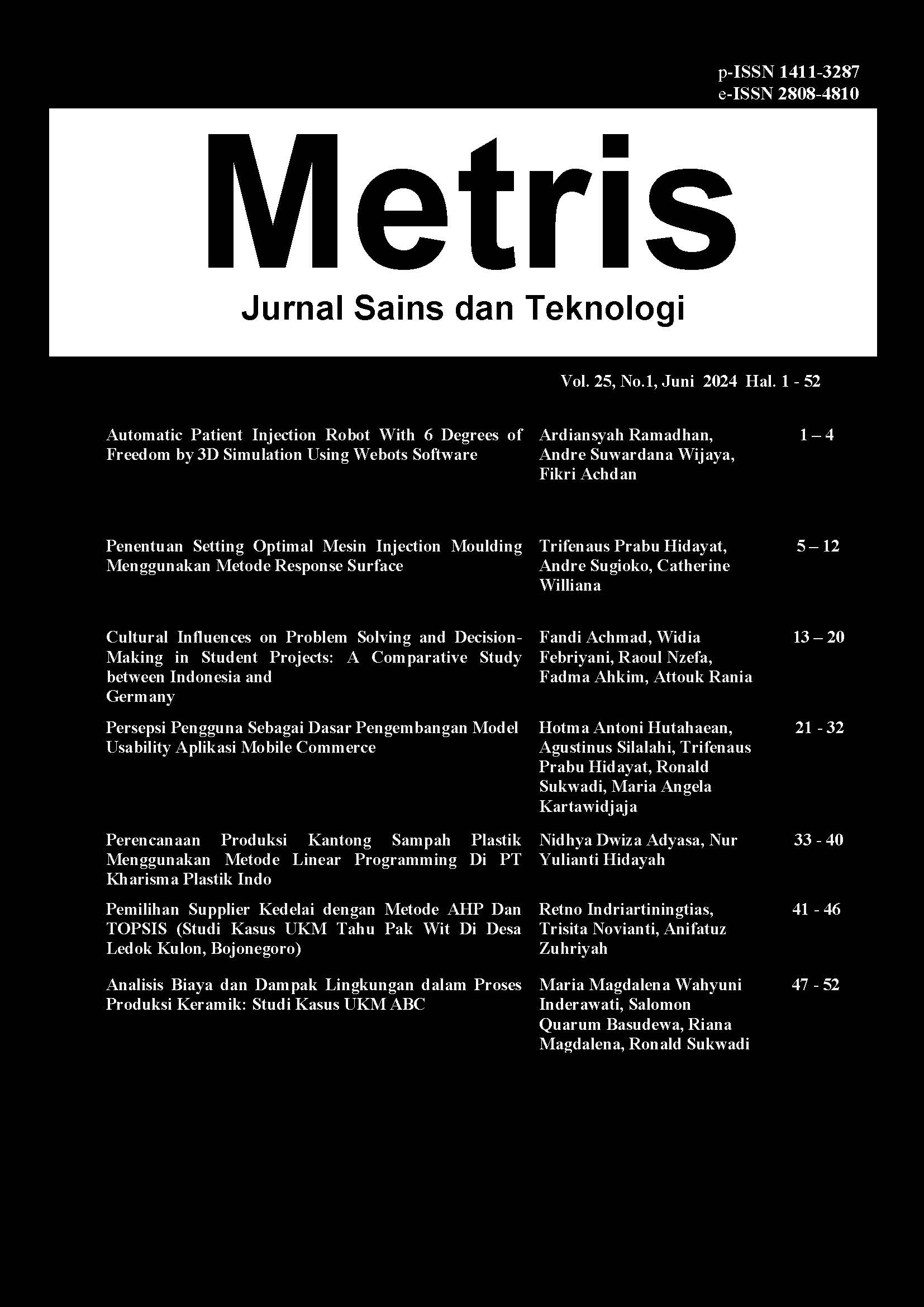Persepsi Pengguna Sebagai Dasar Pengembangan Model Usability Aplikasi Mobile Commerce
DOI:
https://doi.org/10.25170/metris.v25i01.5451Keywords:
usability, m-commerce application, loyaltyAbstract
The intense competition between developers, resulting in efforts to determine users' needs, is increasingly important. Usability An application can affect the continuity of application use. In this study, the user's loyalty is also used to analyze usability. This study examines user perceptions about user interaction characteristics when interacting with the mobile commerce application and considers users' loyalty. This research is essential to find out the needs of users of a mobile commerce application, which can be input to the developer in the design stage. This study uses 149 respondents' online shopping transactions in Jabadetabek and outside Jabodetabek, Indonesia. Data were analyzed using the Structural Equation Modeling (SEM) model. The results showed that users' perception of effectiveness, satisfaction, and learning influenced usability. This model can explain 42.6% of the user's usability variation when using it. This model can explain the usability of the Mobile Commerce application quite well. As a practical implication, this study shows the factors that support the characteristics of user interaction and application systems at the stage of defining the requirements for developing mobile commerce applications.
References
Abushar k, Y. B., Khan, A. I., Alsolami, F. J., Almalawi, A., Alam, M. M., Agrawal, A., Kumar, R., & Khan, R. A. 2021. Usability Evaluation through Fuzzy AHP-TOPSIS Approach: Security Requirement Perspective. Computers, Materials and Continua, 68(1): 1203–1218.
Bowen, J. T., & Chen, S. 2001. The relationship between customer loyalty and customer satisfaction. International Journal of Contemporary Hospitality Management, 13(5): 213–217.
Casaló, L., Flavián, C., & Guinalíu, M. 2008. The role of perceived usability, reputation, satisfaction and consumer familiarity on the website loyalty formation process. Computers in Human Behavior, 24(2): 325–345.Coursaris, C. K. & Kim, D. J. 2006. A qualitative review of empirical mobile usability studies. Paper presented at the 2006 Americas Conference on Information Systems (AMCIS).
Coursaris, C. K. & Kim, D. J., 2011. A MetaAnalytical Review of Empirical Mobile Usability Studies, Journal of Usability Studies, 6(3): 117-171.
Dawood, K. A., Sharif, K. Y., Ghani, A. A., Zulzalil, H., Zaidan, A. A. & Zaidan, B. B. 2020. Towards a unified criteria model for usability evaluation in the context of open source software based on a fuzzy Delphi method, Information and Software Technology, 130: 106453.
Gupta, D.; Ahlawat, A.; Sagar, K. A. 2014. A critical analysis of a hierarchy-based usability model. 2014 International Conference on Contemporary Computing and Informatics (IC3I): 255-260
Gupta, D., Ahlawat, A. & Sagar, K. 2017. Usability prediction and ranking of SDLC models using fuzzy hierarchical usability model. Open Engineering, 7(1): 161-168.
Hair, J. F., C. Black, W., J. Babin, B. & E. Anderson, R. 2010. Multivariate Data Analysis (7th Edition)
Hair, J.F., Hollingsworth, C.L.H., Randolph, A.B. & Chong, A.Y.L. 2017. An updated and expanded assessment of PLS-SEM in information systems research, Industrial Management & Data Systems, 117(3): 442-458.
Hasan, L. A., & Al-Sarayreh, K. T. 2015. An Integrated Measurement Model for Evaluating Usability Attributes. November : 1–6.
Henseler, J., Ringle, C. M., & Sarstedt, M. 2014. A New Criterion for Assessing Discriminant Validity in Variance-Based Structural Equation Modeling. Journal of the Academy of Marketing Science, 43: 115-135.
Jeng, J. 2004. What Is Usability in the Context of the Digital Library. Information Technology and Libraries, 24(2): 47–57.
Ji, Y. G., Park, J. H., Lee, C., & Yun, M. H. 2006. A usability checklist for the usability evaluation of mobile phone user interface. International Journal of Human-Computer Interaction, 20(3): 207–231.
Lee, Y., & Kozar, K. A. 2012. Understanding of website usability: Specifying and measuring constructs and their relationships. Decision
Support Systems, 52(2): 450–463.
Muqtadiroh, F. A., Astuti, H. M., Darmaningrat, E. W. T., & Aprilian, F. R. 2017. Usability Evaluation to Enhance Software Quality of Cultural Conservation System Based on Nielsen Model (WikiBudaya). Procedia Computer Science, 124: 513–521.
Nelson, R., & Staggers, N. (2016). Health Informatics - E-Book: An Interprofessional Approach. In Health Informatics - E-Book.
Nielsen, C.M., Overgaard, M., Pedersen, M.B., Stage J. & Stenild, S. 2006. It’s worth the Hassle!: the added value of evaluating the usability of mobile systems in the field. In: NordiCHI ’06: Proceedings of the 4th Nordic Conference on Human-Computer Interaction.
Pawestri, R.H., Az-Zahra, H. M., & Rusydi, A.N. 2019. Evaluasi Usability Aplikasi Mobile menggunakan Usability Testing dan System Usability Scale (SUS) (Studi Kasus: SOCO, Althea dan Sephora), Jurnal Pengembangan Teknologi Informasi dan Ilmu Komputer, 3(10): 9883–9891.
Ramanayaka, K. H. 2018. Identifying Dimensions and Their Measuring Items for Library Website Usability Acceptance Model: Instrument Development and Validation. Journal of Computers, 13(7): 750–760.
Saputri, I. S. Y., Fadhli, M. & Surya, I. 2017. Penerapan Metode UCD (User Centered Design) Pada E-Commerce Putri IntanShop Berbasis Web, Jurnal Nasional Teknologi dan Sistem Informasi, 3(2):269–278
Singh, T., Malik, S. & Sarkar, D. 2016. Ecommerce website quality assessment based on usability, 2016 International Conference on
Computing, Communication and Automation (ICCCA): 101–105.
Sudjana, A. R. L., & Sfenrianto. 2020. A Model of Factors Influencing E-learning Usability in Toastmasters International. International Journal of Recent Technology and Engineering (IJRTE), 8(6): 327–332.
Thakur, R. 2016. Understanding Customer Engagement and Loyalty: A Case of Mobile Devices for Shopping, Journal of Retailing and Consumer Services, 32: 151–163.
Tullis, T. & Albert, A. 2013. Measuring the user experience collecting, analyzing, and presenting usability metrics, 2nd Edition. Morgan Kaufmann, Waltham
Tenenhaus, M., Vinzi, V. E., Chatelin, Y. M., & Lauro, C. 2005. PLS path modeling, Computational Statistics and Data Analysis, 48(1): 159-205.
Wolf, E. J., Harrington, K. M., Clark, S. L., & Miller, M. W. 2013. Sample Size Requirements for Structural Equation Models: An Evaluation of Power, Bias, and Solution Propriety, duc Psychol Meas, 73(6): 913–934.












